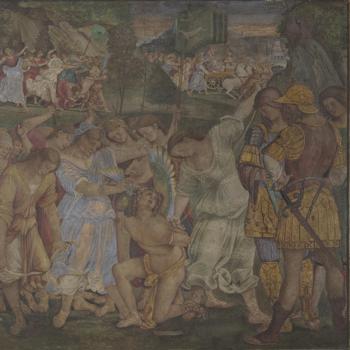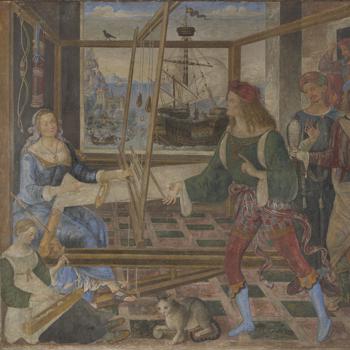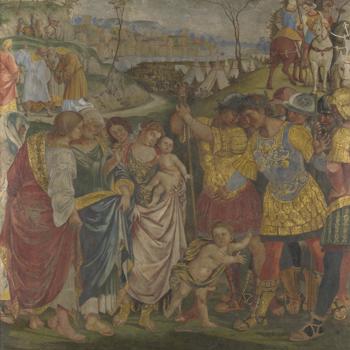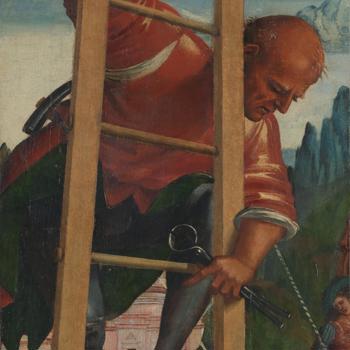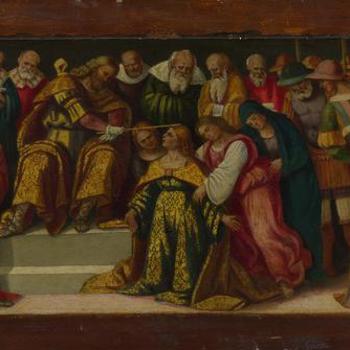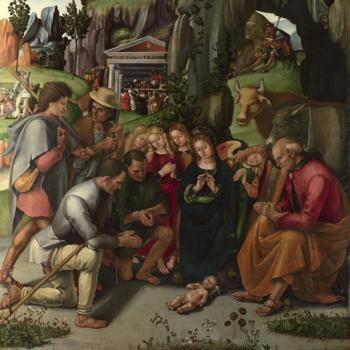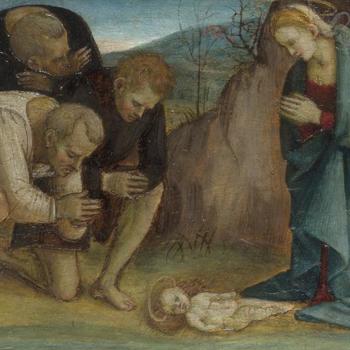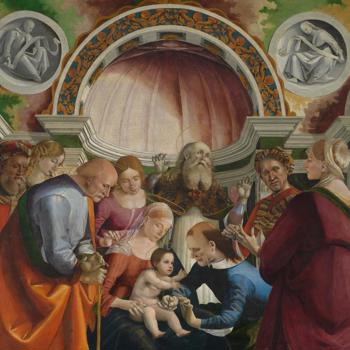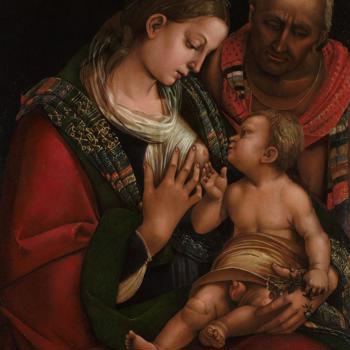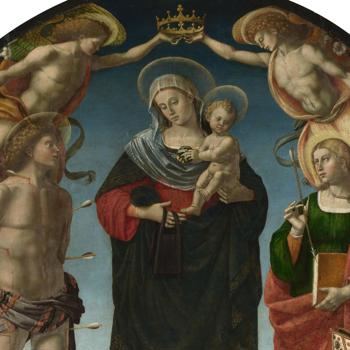Luca Signorelli, The Triumph of Chastity: Love Disarmed and Bound
Three Frescoes from Palazzo del Magnifico, Siena
These three paintings in fresco (painted directly on to wet plaster) once decorated the walls of a room in the Petrucci family palace in Siena. Each wall was painted with two frescoes, positioned on either side of a doorway or window. The ceiling, which can be seen at the Metropolitan Museum of Art, New York, contained 20 frescoes of mythological scenes, divided by carved, painted and gilded stucco (plaster), produced by Pintoricchio and his workshop. At the centre was the Petrucci coat of arms, surrounded by flying putti (cherubs).
The frescoes were commissioned by Pandolfo Petrucci to celebrate the marriage of his son to the niece of Pope Pius III. The occasion provided an opportunity to show off his fashionable interest in classical history – through scenes from ancient Greek and Roman literature and history, the frescoes illustrate family values and the virtues important to marriage.
These three paintings made in fresco belong to a series of eight which once decorated the walls of a room in the Palazzo Magnifico, the Petrucci family palace in the Tuscan city of Siena. Every inch of the room, which was in the upper storey of a medieval tower, was painted and gilded including the ceiling.
The decoration was commissioned by Pandolfo Petrucci, the ruler of Siena, to celebrate the marriage of his son Borghese to Vittoria Piccolomini, the niece of Pope Pius III, an illustrious union that Pandolfo was keen to commemorate. The room, which contained little furniture – a table, chests and some benches – was used for receptions but also served as the backdrop to Pandolfo’s meetings regarding official business.
Eighteenth-century descriptions help us to imagine what the room, which became known as the camera bella (‘the beautiful room’), looked like originally. There were two frescoes per wall, positioned on either side of a doorway or window. Along with the three in our collection, there were two by Girolamo Genga (now in the Pinacoteca Nazionale, Siena), two more by Signorelli and one by Pintoricchio (all three now lost). Pintoricchio was an obvious choice as he had been commissioned by a member of the Piccolomini family to decorate the library in Siena Cathedral only a few years earlier.
The upper part of the room was decorated with eight medallions that contained more narrative scenes (now lost). The gilded stucco ceiling which can be seen at the Metropolitan Museum of Art, New York, featured 20 frescoes of mythological scenes painted by Pintoricchio and his workshop. At the centre was the Petrucci coat of arms, surrounded by flying putti. The upper part of the room contained arches painted with images of the nine muses, among others.
The floor was decorated with ceramic tiles painted with coats of arms and grotesques (decorative, imaginary beasts entwined in foliage). Many still survive and some show the Petrucci coat of arms along with that of the Piccolomini family. The Piccolomini are not present in the ceiling decoration, where the Petrucci coats of arms is displayed centrally alone – or indeed elsewhere in the room. The blue and gold colours of the Petrucci family dominate, suggesting that part of it might have been commissioned before the marriage.
Pandolfo was obviously interested in ancient history and mythology and the images in the room offered him a way to express his learning on the subject – key knowledge for any educated Renaissance noble. The ceiling design was based upon that in the domus aurea (‘the golden house’) in Rome, the home of the second-century emperor Nero, which was discovered in the late fifteenth century. Fictive stone tablets at the junction of the ceiling and the upper wall were inscribed with quotes from Latin texts. The episodes from Greek and Roman history and literature depicted on the main part of the walls demonstrate qualities such as fidelity, chastity and generosity of spirit, relevant not only in the context of wedding celebrations but also as a backdrop for state business.
The frescoes suffered damage when they were removed from the wall, as can be seen from their crumbly texture.

